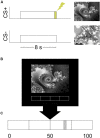Psychopaths Show Enhanced Amygdala Activation during Fear Conditioning
- PMID: 27014154
- PMCID: PMC4785144
- DOI: 10.3389/fpsyg.2016.00348
Psychopaths Show Enhanced Amygdala Activation during Fear Conditioning
Erratum in
-
Corrigendum: Psychopaths Show Enhanced Amygdala Activation during Fear Conditioning.Front Psychol. 2017 Aug 22;8:1457. doi: 10.3389/fpsyg.2017.01457. eCollection 2017. Front Psychol. 2017. PMID: 28845153 Free PMC article.
Abstract
Psychopathy is a personality disorder characterized by emotional deficits and a failure to inhibit impulsive behavior and is often subdivided into "primary" and "secondary" psychopathic subtypes. The maladaptive behavior related to primary psychopathy is thought to reflect constitutional "fearlessness," while the problematic behavior related to secondary psychopathy is motivated by other factors. The fearlessness observed in psychopathy has often been interpreted as reflecting a fundamental deficit in amygdala function, and previous studies have provided support for a low-fear model of psychopathy. However, many of these studies fail to use appropriate screening procedures, use liberal inclusion criteria, or have used unconventional approaches to assay amygdala function. We measured brain activity with BOLD imaging in primary and secondary psychopaths and non-psychopathic control subjects during Pavlovian fear conditioning. In contrast to the low-fear model, we observed normal fear expression in primary psychopaths. Psychopaths also displayed greater differential BOLD activity in the amygdala relative to matched controls. Inverse patterns of activity were observed in the anterior cingulate cortex (ACC) for primary versus secondary psychopaths. Primary psychopaths exhibited a pattern of activity in the dorsal and ventral ACC consistent with enhanced fear expression, while secondary psychopaths exhibited a pattern of activity in these regions consistent with fear inhibition. These results contradict the low-fear model of psychopathy and suggest that the low fear observed for psychopaths in previous studies may be specific to secondary psychopaths.
Keywords: amygdala; anxiety; fMRI; fear conditioning; psychopathy.
Figures




Similar articles
-
Deficient fear conditioning in psychopathy: a functional magnetic resonance imaging study.Arch Gen Psychiatry. 2005 Jul;62(7):799-805. doi: 10.1001/archpsyc.62.7.799. Arch Gen Psychiatry. 2005. PMID: 15997022
-
Primary and Secondary Variants of Psychopathy in a Volunteer Sample Are Associated With Different Neurocognitive Mechanisms.Biol Psychiatry Cogn Neurosci Neuroimaging. 2018 Dec;3(12):1013-1021. doi: 10.1016/j.bpsc.2018.04.002. Epub 2018 Apr 12. Biol Psychiatry Cogn Neurosci Neuroimaging. 2018. PMID: 29752216 Free PMC article.
-
The interplay of attention and emotion: top-down attention modulates amygdala activation in psychopathy.Cogn Affect Behav Neurosci. 2013 Dec;13(4):757-70. doi: 10.3758/s13415-013-0172-8. Cogn Affect Behav Neurosci. 2013. PMID: 23712665 Free PMC article.
-
Integration of emotion and cognition in patients with psychopathy.Prog Brain Res. 2006;156:457-66. doi: 10.1016/S0079-6123(06)56025-X. Prog Brain Res. 2006. PMID: 17015096 Review.
-
Parsing fear: A reassessment of the evidence for fear deficits in psychopathy.Psychol Bull. 2016 Jun;142(6):573-600. doi: 10.1037/bul0000040. Epub 2016 Feb 8. Psychol Bull. 2016. PMID: 26854867 Review.
Cited by
-
Neural Mechanisms Involved in Social Conformity and Psychopathic Traits: Prediction Errors, Reward Processing and Saliency.Front Behav Neurosci. 2019 Jul 16;13:160. doi: 10.3389/fnbeh.2019.00160. eCollection 2019. Front Behav Neurosci. 2019. PMID: 31379532 Free PMC article.
-
Using physiological biomarkers in forensic psychiatry: a scoping review.Front Psychiatry. 2025 Apr 29;16:1580615. doi: 10.3389/fpsyt.2025.1580615. eCollection 2025. Front Psychiatry. 2025. PMID: 40365003 Free PMC article.
-
Functional neural correlates of psychopathy: a meta-analysis of MRI data.Transl Psychiatry. 2020 May 6;10(1):133. doi: 10.1038/s41398-020-0816-8. Transl Psychiatry. 2020. PMID: 32376864 Free PMC article.
-
Structural equation modeling of the associations between amygdala activation, personality, and internalizing, externalizing symptoms of psychopathology.Personal Neurosci. 2020 Jul 14;3:e8. doi: 10.1017/pen.2020.8. eCollection 2020. Personal Neurosci. 2020. PMID: 32743337 Free PMC article.
-
Psychopathy is associated with shifts in the organization of neural networks in a large incarcerated male sample.Neuroimage Clin. 2019;24:102083. doi: 10.1016/j.nicl.2019.102083. Epub 2019 Nov 9. Neuroimage Clin. 2019. PMID: 31795050 Free PMC article.
References
-
- American Psychiatric Association (2013). Diagnostic and Statistical Manual of Mental Disorders: Dsm-5. Arlington, VA: Amer Psychiatric Pub Incorporated.
LinkOut - more resources
Full Text Sources
Other Literature Sources

